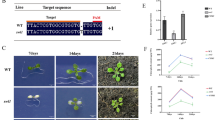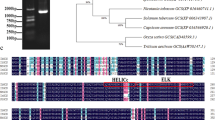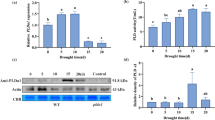Abstract
In extracts from the primary leaf blade of sugar beet (Beta vulgaris L.) we separated a chloroplastic isoform (GS 2) of glutamine synthetase (GS, EC 6.3.1.2) and one or two (depending on leaf age) cytosolic isoforms (GS 1a and GS 1b). The latter were prominent in the early (GS 1a) and late stages of leaf ontogeny (GS 1a and GS 1b), whereas during leaf maturation GS 2 was the predominantly active GS isoform. The GS 1 isoforms were active exclusively in the octameric state although tetrameric GS 1 protein was detected immunologically. Their activity stayed at a relatively constant level during leaf ontogeny; an increase was observed only in the senescent leaf. The activity of GS 2, however, changed drastically during primary leaf ontogeny and was modulated by changes in the oligomeric state of the active enzyme. In the early and late stages of leaf ontogeny when GS 2 activity was low (lower than that of the GS 1 isoforms), GS 2 was active only in the octameric state. In the maturing leaf, when GS 2 activity had reached its maximum level (much higher than that of the GS 1 isoforms), 80‰ of total GS 2 activity was due the activity of the tetrameric form of the enzyme and 20‰ was due to octameric GS 2. Tetrameric GS 2 was a hetero-tetramer and thus not the unspecific dissociation product of homo-octameric GS 2. In addition, GS 2 activity was modulated by an activation/inactivation of the tetrameric GS 2 protein. Due to an activation of the GS 2 tetramer, the activity of tetrameric GS 2 increased during leaf maturation from zero level 23-fold compared with that of GS 1a and 18-fold compared with that of GS 1b. Possible activators of tetrameric GS 2 are thiol-reactive substances. During leaf senescence, GS 2 activity decreased to zero; this decrease was due to an inactivation of the tetrameric GS 2 protein probably caused by oxidation.
Similar content being viewed by others
Abbreviations
- FLL:
-
final lamina length
- FPLC:
-
fast protein liquid chromatography
- GS:
-
glutamine synthetase
- GHA:
-
γ-glutamyl hydroxamate
- Rubisco:
-
ribulose-1,5-bisphosphate carboxylase/oxygenase
References
Behringer, H., Koch, K. (1985) Comparative studies on the distribution of foliar or root applied 15N-nitrogen in Beta vulgaris species. Z. Pflanzenernähr. Bodenkd. 148, 214–221
Beiß, U., Bürcky, K. (1993) Effect of nitrogen supply on nitrogen uptake and concentration in sugar beet leaves in pot trials. Zuckerindustrie 118, 357–365
Bradford, M.M. (1976) A rapid and sensitive method for the quantification of microgram quantities of protein utilizing the principle of protein-dye binding. Anal. Biochem. 72, 248–254
Bürcky, K., Biscoe, P.V. (1983) Stickstoff im Rübenblatt und N-Translokation aus alternden Blättern. IIRB-Symposium Nitrogen and sugar-beet, Bruxelles, pp. 63–75, Int. Institut für Zukkerrübenforschung, Brüssel
Chen, J., Kennedy, I.R. (1985) Purification and properties of lupin nodule glutamine synthetase. Phytochemistry 24, 2167–2172
Dávila, G., Lara, M., Guzmán, J., Mora, J. (1980) Relation between structure and function of Neurospora crassa glutamine synthetase. Biochem. Biophys. Res. Commun. 92, 134–140
Dunbar, B.S., Kimura, H., Timmons, T.M. (1990) Protein analysis using high-resolution two-dimensional poyacrylamide gel electrophoresis. Methods Enzymol. 182, 441–459
Edwards, I.E., Coruzzi, G.M. (1989) Photorespiration and light act in concert to regulate the expression of the nuclear gene for chloroplast glutamine synthetase. Plant Cell 1, 241–248
Edwards, J.W., Walker, E.L., Coruzzi, G.M. (1990) Cell-specific expression in transgenic plants reveals nonoverlapping roles for chloroplast and cytosolic glutamine synthetase. Proc. Natl. Acad. Sci. USA 87, 3459–3463
Elmlinger, M.W., Mohr, H. (1992) Glutamine synthetase in Scots pine seedlings and its control by blue light and light absorbed by phytochrome. Planta 188, 396–402
Evstigneeva, Z.G., Pushkin, A.V., Solovieva, N.A., Golova, T.V., Kretowich, W.L. (1981) Effect of light on the formation of multiple molecular forms of glutamine synthetase in plants. Mol. Cell. Biochem. 40, 123–125
Fellows, R.J., Geiger, D.R. (1974) Structural and physiological changes in sugar beet leaves during sink to source conversion. Plant Physiol. 54, 877–885
Giaquinta, R. (1978) Source and sink leaf metabolism in relation to phloem translocation. Plant Physiol. 61, 380–385
Heldt, H.W., Sauer, F. (1971) The inner membrane of the chloroplast envelope as the site of specific metabolite transport. Biochim. Biophys. Acta 234, 83–91
Hirel, B., Gadal, P. (1980) Glutamine synthetase in rice. Plant Physiol. 66, 619–623
Hirel, B., Gadal, P. (1982) Glutamine synthetase isoforms in leaves of a C4 plant: Sorghum vulgare. Physiol. Plant. 54, 69–74
Hoelzle, I., Finer, J.J., McMullen, M.D., Streeter, J.G. (1992) Induction of glutamine synthetase activity in nonnodulated roots of Glycine max, Phaseolus vulgaris, and Pisum sativum. Plant Physiol. 100, 525–528
Höpfner, M., Reifferscheid, G., Wild, A. (1988) Molecular composition of glutamine synthetase of Sinapis alba L. Z. Naturforsch. 43c, 194–198
Jeschke, W.D., Pate, J.S. (1992) Temporal patterns of uptake, flow and utilization of nitrate, reduced nitrogen and carbon in a leaf of salt-treated castor bean (Ricinus communia L.). J. Exp. Bot. 43, 393–402
Joy, K.W. (1967) Carbon and nitrogen sources for protein synthesis and growth of sugarbeet leaves. J. Exp. Bot. 18, 140–150
Joy, K.W., Antcliffe, A.J. (1966) Translocation of amino-acids in sugar beet. Nature 211, 210–211
Kamachi, K., Yamaya, T., Hayakawa, T., Mae, T., Ojima, K. (1992) Vascular bundle-specific localization of cytosolic glutamine synthetase in rice leaves. Plant Physiol. 99, 1481–1486
Kozaki, A., Sakamoto, A., Takeba, G. (1992) The promotor of the gene for plastidic glutamine synthetase (GS2) from rice is developmentally regulated and exhibits substrate-induced expression in transgenic tobacco plants. Plant Cell Physiol. 33, 233–238
Laemmli, U.K. (1970) Cleavage of structural proteins during the assembly of the head of bacteriophage T4. Nature 227, 680–685
McNally, S.F., Hirel, B., Gadal, P., Mann, A.F., Stewart, G. (1983) Glutaminsynthetase of higher plants. Plant Physiol. 72, 22–25
Mae, T., Makino, A., Ohira, K. (1983) Changes in the amounts of ribulose bisphosphate carboxylase synthesized and degraded during the life span of rice leaf (Oryza sativa L.). Plant Cell Physiol. 24, 1079–1086
Mäck, G. (1988) Untersuchungen zum Stickstoffmetabolismus in Zuckerrübenpflanzen unterschiedlicher Entwicklungsstadien. PhD-Thesis, Universität Göttingen, Germany
Mäck, G., Tischner, R. (1990) Glutamine synthetase oligomers and isoforms in sugarbeet (Beta vulgaris L.). Planta 181, 10–17
Manderscheid, R., Wild, A. (1985) The effect of thiol compounds on the glutamate affinity of the chloroplastic glutamine synthetase from mustard leaves. Z. Naturforsch. 40c, 295–296
Mann, A.F., Fentem, P.A., Stewart, G.R. (1979) Identification of two forms of glutamine synthetase in barley (Hordeum vulgare). Biochem. Biophys. Res. Commun. 88, 515–521
Mourioux, G., Douce, R. (1981) Slow passive diffusion of orthophosphate between intact isolated chloroplasts and suspending medium. Plant Physiol. 67, 470–473
Neuhoff, V., Stamm, R., Eibl, H. (1985) Clear background and highly sensitive protein staining with Coomassie Blue dyes in polyacrylamide gels: A systematic analysis. Electrophoresis 6, 427–448
Redinbaugh, M.G., Campbell, W. H. (1993) Glutamine synthetase and ferredoxin-dependent glutamate synthase expression in the maize (Zea mays) root primary response to nitrate. Plant Physiol. 101, 1249–1255
Rhodes, D., Sims, A.P., Stewart, G.R. (1979) Glutamine synthetase and the control of nitrogen assimilation in Lemna minor L. In: Nitrogen assimilation of plants, pp. 501–520, Hewitt, E.J., Cutting, C.V., eds. Academic Press, London
Riedel, J. (1993) Regulation der Glutaminsynthetase in Beta vulgaris L. Diploma Thesis, University of Göttingen, Germany
Suissa, M. (1983) Spectrophotometric quantitation of silver grains eluted from autoradiograms. Anal. Biochem. 133, 511–514
Ta, C.T. (1991) Nitrogen metabolism in the stalk tissue of maize. Plant Physiol. 97, 1375–1380
Wallsgrove, R.M., Keys, A.J., Lea, P.J., Miflin, B.J. (1983) Photosynthesis, photorespiration and nitrogen metabolism. Plant Cell Environm. 6, 301–309
Wilk, S., Meister, A., Haschemeyer, R.H. (1969) Studies on the structure of bovine brain glutamine synthetase. Biochemistry 8, 3168–3174
Author information
Authors and Affiliations
Additional information
Dr. Roger Wallsgrove's (Rothamsted Experimental Station, Harpenden, UK) generous gift of GS antiserum is greatly appreciated.
Rights and permissions
About this article
Cite this article
Mäck, G., Tischner, R. Activity of the tetramer and octamer of glutamine synthetase isoforms during primary leaf ontogeny of sugar beet (Beta vulgaris L.). Planta 194, 353–359 (1994). https://doi.org/10.1007/BF00197535
Received:
Accepted:
Issue Date:
DOI: https://doi.org/10.1007/BF00197535




